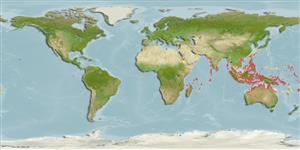Teleostei (teleosts) >
Tetraodontiformes (Puffers and filefishes) >
Balistidae (Triggerfishes)
Etymology: Rhinecanthus: Greek, rhinos = nose + Greek, akantha = thorn (Ref. 45335).
More on author: Linnaeus.
Environment: milieu / climate zone / depth range / distribution range
Ecology
Marine; reef-associated; depth range 1 - 20 m (Ref. 9710). Tropical; 32°N - 21°S
Indo-West Pacific: Seychelles, Chagos Archipelago through northern Australia to Vanuatu, north to southern Japan.
Size / Weight / Age
Maturity: Lm ? range ? - ? cm
Max length : 23.0 cm TL male/unsexed; (Ref. 9710); common length : 19.0 cm TL male/unsexed; (Ref. 5450)
Inhabit subtidal reef flats and protected lagoons, Ref. 48637. Found mainly in rubble-algal habitat and usually in loose aggregations. Sometimes solitary (Ref. 90102). Shy species, usually swimming away or when small, diving into holes (Ref. 48637). Oviparous (Ref. 205). Also taken by drive-in nets (Ref. 9770).
Life cycle and mating behavior
Maturities | Reproduction | Spawnings | Egg(s) | Fecundities | Larvae
Distinct pairing (Ref. 205).
Matsuura, K., 2001. Balistidae. Triggerfishes. p. 3911-3928. In K.E. Carpenter and V. Niem (eds.) FAO species identification guide for fishery purposes. The living marine resources of the Western Central Pacific. Vol. 6. Bony fishes part 4 (Labridae to Latimeriidae), estuarine crocodiles. FAO, Rome. (Ref. 9770)
IUCN Red List Status (Ref. 130435)
Threat to humans
Harmless
Human uses
Fisheries: minor commercial; aquarium: commercial
Tools
Special reports
Download XML
Internet sources
Estimates based on models
Preferred temperature (Ref.
123201): 26.2 - 29.3, mean 28.6 °C (based on 2192 cells).
Phylogenetic diversity index (Ref.
82804): PD
50 = 0.5078 [Uniqueness, from 0.5 = low to 2.0 = high].
Bayesian length-weight: a=0.01820 (0.01073 - 0.03085), b=2.92 (2.77 - 3.07), in cm total length, based on LWR estimates for this species & (Sub)family-body (Ref.
93245).
Trophic level (Ref.
69278): 3.5 ±0.3 se; based on size and trophs of closest relatives
Resilience (Ref.
120179): High, minimum population doubling time less than 15 months (Preliminary K or Fecundity.).
Fishing Vulnerability (Ref.
59153): Low vulnerability (13 of 100).
Nutrients (Ref.
124155): Calcium = 57.4 [24.4, 142.0] mg/100g; Iron = 0.671 [0.330, 1.504] mg/100g; Protein = 18.4 [16.3, 20.6] %; Omega3 = 0.112 [0.057, 0.220] g/100g; Selenium = 27.3 [14.0, 57.6] μg/100g; VitaminA = 63.1 [18.4, 222.5] μg/100g; Zinc = 1.21 [0.81, 1.79] mg/100g (wet weight);
